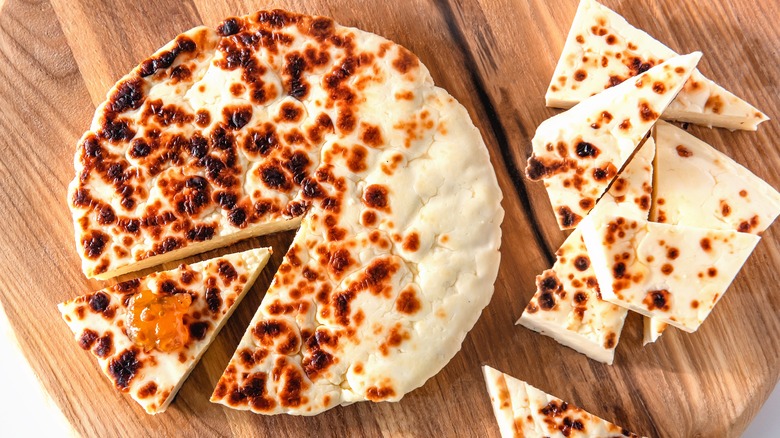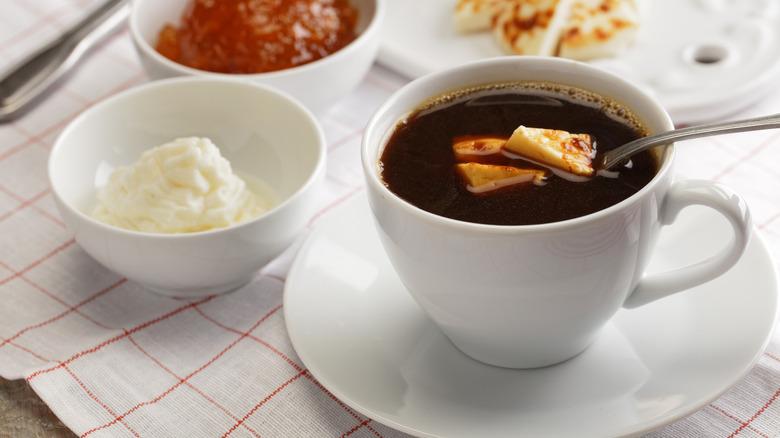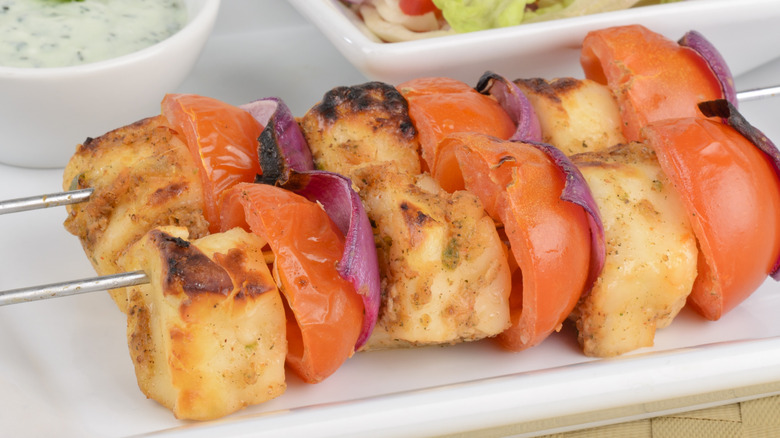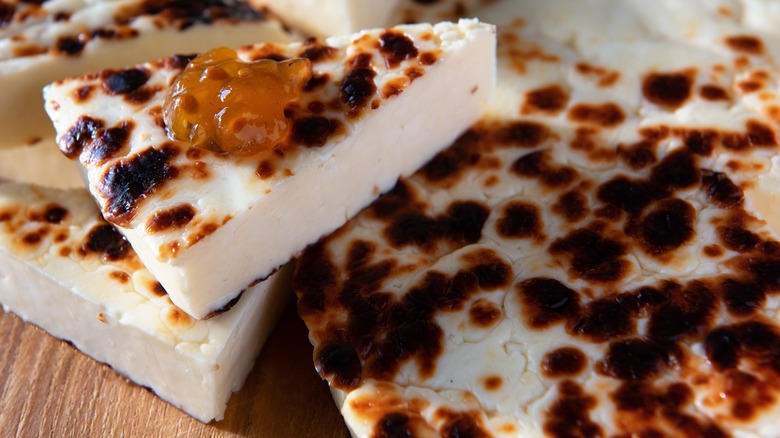Finnish Bread Cheese Is A Savory Breakfast Treat You Can Dip In Coffee
You've heard of cheesy bread, now get ready for bread cheese — or, more specifically, the unique bread-like cheese that hails from Finland, leipäjuusto. Translated literally to 'bread cheese" in Finnish, this quirky treat is sometimes known as juustoleipä, cheese bread, as well as Finnish squeaky cheese due to the way it squeaks when chewed. It does, in fact, have a remarkable bread-like texture down to the porous and nicely browned crust that forms when grilled. And like halloumi and paneer, it softens up instead of melting when heated, making it really and truly seem like a bread.
It's used as a bread substitute in Finland, sometimes served with syrup or honey at breakfast or dessert. And as strange as the combination of coffee and cheese might sound, Finnish bread cheese is most commonly enjoyed with a good cup of coffee In Finland. When it comes to cheeses to try at least once in your lifetime, juustoleipä is definitely one for the list.
What is Finnish bread cheese?
Traditionally made with reindeer milk, juustoleipä was a food of the nomadic Saami tribes of Scandinavia. It originated about 200 years ago in northern Finland and became a protein-laden staple that could be dried and stored for years. Like many other foods, customs, and loanwords, eventually, the Scandinavians of Finland took to the bread cheese as well as the tradition of dipping it in coffee. This cheese-laden coffee is actually called Kaffeost if you ever wanted to order it from a Finnish café.
At some point, juustoleipä also made it over to America, where it established a newfound popularity in the Midwest — specifically, Wisconsin. Among the many unique cheeses Wisconsin is known for, juustoleipä managed to establish itself as a local specialty. While traditional juustoleipä is usually grilled and eaten plain with coffee, it took on a Midwestern spin of being made with other ingredients melted into it for an easy handheld snack. And it's usually paired with beer or wine in the region, similar to more conventional soft cheeses. Lighter beers and wines on the crisper and sweeter sides are known to work best with juustoleipä.
How is Finnish bread cheese made?
While juustoleipä follows the same general science of how any cheese is made, a few quirks make it the way it is. First, it's unique in that it uses no acidity or introduced acidic cultures to curdle into curds and whey — it's boiled to a scorching 195 degrees Fahrenehit until the whey proteins separate from the liquid. Then, the curds are gathered, drained, molded into a firm block, and baked until a caramelized outer crust gives it its signature resemblance to a regular piece of grilled flatbread.
Traditionally, the curds — usually set into a circular block around one inch thick — are made from reindeer milk, goat milk, or what is known as beestings, the high fat-content milk produced after a cow has a newborn. The Midwestern version uses pasteurized cow's milk instead and more commonly sets the curds into rectangular blocks before baking in the caramelized crust. According to Sid Cook — a Wisconsin cheesemaker and owner of Carr Valley— Finnish bread cheese typically lasts six months in the fridge and up to a year in the freezer.
Finnish bread cheese vs. halloumi vs. paneer
A squeaky cheese with a chewy texture that doesn't melt half as easily as other cheeses? Let's be honest: juustoleipä probably reminds you of halloumi or paneer. The resemblances are quite remarkable despite the key differences in production, taste, and usage. For example, juustoleipä and halloumi are both made in markedly less acidic processes that rely on fat and heat to create the solid curds. Meanwhile, paneer does have acid added to its heated form like most other cheeses — what gives it its signature texture is actually the fact that it's dunked in cold water after being pressed.
Their different flavors also make them better suited to different kinds of dishes. Halloumi has a tang distinctly reminiscent of feta and is often served with grilled vegetables or salads. Paneer has a versatile mildness and is used as an ingredient to soak up stronger flavors from dishes like masala curry. And finally, juustoleipä is as mild as paneer but with a nutty and almost buttery taste that makes it especially perfect for pairing with coffee, jam, syrup, and other breakfast-y treats you'd usually have with bread. Alongside the buttery taste, it has a slight saltiness, not unlike brie or mozzarella, forming a mild and versatile base for any number of pairings. In Wisconsin, it's sold in varieties like garlic, chipotle, and jalapeño flavored, as well as other savory flavors.
Where can you buy Finnish bread cheese?
While it's easiest to find in Wisconsin and other Midwestern states, Finnish bread cheese has been rising in popularity as of late. Most notably, Trader Joe's lists garlic and pizza-flavored varieties on its website — however, it's hard to guarantee availability in every single one of the many locations across the country. Depending on where you live, you may also have some luck asking your local independent cheesemaker if they stock any Finnish bread cheese of their own.
If all else fails, you can order directly from Midwestern specialty cheesemakers. Hardy and less vulnerable to spoilage than most cheeses, Finnish bread cheese can be ordered and shipped from Wisconsin companies like Wisconsin Cheese or Carr Valley. Be warned that the shipping fees may not be as appetizing as the bread cheese itself; if you're really hankering for a helping of juustoleipä, you'll probably want to order in bulk to make the shipping worth it.




